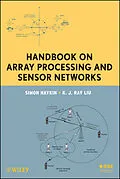A handbook on recent advancements and the state of the art in
array processing and sensor Networks
Handbook on Array Processing and Sensor Networks provides
readers with a collection of tutorial articles contributed by
world-renowned experts on recent advancements and the state of the
art in array processing and sensor networks.
Focusing on fundamental principles as well as applications, the
handbook provides exhaustive coverage of: wavelets; spatial
spectrum estimation; MIMO radio propagation; robustness issues in
sensor array processing; wireless communications and sensing in
multi-path environments using multi-antenna transceivers; implicit
training and array processing for digital communications systems;
unitary design of radar waveform diversity sets; acoustic array
processing for speech enhancement; acoustic beamforming for hearing
aid applications; undetermined blind source separation using
acoustic arrays; array processing in astronomy; digital 3D/4D
ultrasound imaging technology; self-localization of sensor
networks; multi-target tracking and classification in collaborative
sensor networks via sequential Monte Carlo; energy-efficient
decentralized estimation; sensor data fusion with application to
multi-target tracking; distributed algorithms in sensor networks;
cooperative communications; distributed source coding; network
coding for sensor networks; information-theoretic studies of
wireless networks; distributed adaptive learning mechanisms;
routing for statistical inference in sensor networks; spectrum
estimation in cognitive radios; nonparametric techniques for
pedestrian tracking in wireless local area networks; signal
processing and networking via the theory of global games;
biochemical transport modeling, estimation, and detection in
realistic environments; and security and privacy for sensor
networks.
Handbook on Array Processing and Sensor Networks is the
first book of its kind and will appeal to researchers, professors,
and graduate students in array processing, sensor networks,
advanced signal processing, and networking.
Autorentext
Simon Haykin, PhD, is a Distinguished University Professor at McMaster University, Hamilton, Ontario. K. J. Ray Liu is a Distinguished Scholar-Teacher at the University of Maryland, College Park. He is the recipient of numerous honors and awards including best paper awards from IEEE Signal Processing Society, IEEE Vehicular Technology Society, and EURASIP, as well as recognition from the University of Maryland, including Invention of the Year Award, Poole and Kent Senior Faculty Teaching Award, and Outstanding Faculty Research Award. Dr. Liu is a Fellow of the IEEE and AAAS.
Zusammenfassung
A handbook on recent advancements and the state of the art in array processing and sensor Networks
Handbook on Array Processing and Sensor Networks provides readers with a collection of tutorial articles contributed by world-renowned experts on recent advancements and the state of the art in array processing and sensor networks.
Focusing on fundamental principles as well as applications, the handbook provides exhaustive coverage of: wavelets; spatial spectrum estimation; MIMO radio propagation; robustness issues in sensor array processing; wireless communications and sensing in multi-path environments using multi-antenna transceivers; implicit training and array processing for digital communications systems; unitary design of radar waveform diversity sets; acoustic array processing for speech enhancement; acoustic beamforming for hearing aid applications; undetermined blind source separation using acoustic arrays; array processing in astronomy; digital 3D/4D ultrasound imaging technology; self-localization of sensor networks; multi-target tracking and classification in collaborative sensor networks via sequential Monte Carlo; energy-efficient decentralized estimation; sensor data fusion with application to multi-target tracking; distributed algorithms in sensor networks; cooperative communications; distributed source coding; network coding for sensor networks; information-theoretic studies of wireless networks; distributed adaptive learning mechanisms; routing for statistical inference in sensor networks; spectrum estimation in cognitive radios; nonparametric techniques for pedestrian tracking in wireless local area networks; signal processing and networking via the theory of global games; biochemical transport modeling, estimation, and detection in realistic environments; and security and privacy for sensor networks.
Handbook on Array Processing and Sensor Networks is the first book of its kind and will appeal to researchers, professors, and graduate students in array processing, sensor networks, advanced signal processing, and networking.
Inhalt
Preface (Simon Haykin and K. J. Ray Liu).
Contributors.
Introduction (Simon Haykin).
PART I: FUNDAMENTAL ISSUES IN ARRAY SIGNAL PROCESSING.
1. Wavefields. (Alfred Hanssen).
1.1 Introduction.
1.2 Harmonizable Stochastic Processes.
1.3 Stochastic Wavefields.
1.4 Wave Dispersion.
1.5 Conclusions.
1.6 Acknowledgements.
References.
2. Spatial Spectrum Estimation (Petar M. Djuri).
2.1 Introduction.
2.2 Fundamentals.
2.3 Temporal Spectrum Estimation.
2.4 Spatial Spectrum Estimation.
2.5 Final Remarks.
References.
3. MIMO Radio Propagation (Tricia J. Willink).
3.1 Introduction.
3.2 Space-Time Propagation Environment.
3.3 Propagation Models.
3.4 Measured Channel Characteristics.
3.5 Stationarity.
3.6 Summary.
References.
4. Robustness Issues in Sensor Array Processing (Alex B. Gershman).
4.1 Introduction.
4.2 Direction-of-Arrival Estimation.
4.3 Adaptive Beamforming.
4.4 Conclusions.
Acknowledgments.
References.
5. Wireless Communication and Sensing in Multipath Environments Using Multiantenna Transceivers (Akbar M. Sayeed and Thiagarajan Sivanadyan).
5.1 Introduction and Overview.
5.2 Multipath Wireless Channel Modeling in Time, Frequency and Space.
5.3 Point-to-Point MIMO Wireless Communication Systems.
5.4 Active Wireless Sensing with Wideband MIMO Transceivers.
5.5 Concluding Remarks.
References.
PART II: NOVEL TECHNIQUES FOR AND APPLICATIONS OF ARRAY SIGNAL PROCESSING.
6. Implicit Training and Array Processing for Digital Communication Systems (Aldo G. Orozco-Lugo, Mauricio Lara, and Desmond C. McLernon).
6.1 Introduction.
6.2 Classification of Implicit Training Methods.
6.3 IT-Based Estimation for a Single User.
6.4 IT-Based Estimation for Multiple Users Exploiting Array Processing: Continuous Transmission.
6.5 IT-Based Estimation for Multiple Users Exploiting Array Processing: Packet Transmission.
6.6 Open Research Problems.
Acknowledgments.
References.
7. Unitary Design of Radar Waveform Diversity Sets (Michael D. Zoltowski, Tariq R. Qureshi, Robert Calderbank, and Bill Moran).
7.1 Introduction.
7.2 2 x 2 Space-Time Diversity Waveform Design.
7.3 4 x 4 Space-Time Diversity Waveform Design.
7.4 Waveform Families Based on Kronecker Products.
7.5 Introduction to Data-Dependent Waveform Design.
7.6 3 x 3 and 6 x 6 Waveform Scheduling.
7.7 Summary.
References.
8. Acoustic Array Processing for Speech Enhancement (Markus Buck, Eberhard Hänsler, Mohamed Krini, Gerhard Schmidt an…
